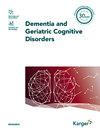记忆临床队列中使用自动MRI的阿尔茨海默病海马萎缩亚型的临床意义
IF 2.2
4区 医学
Q3 CLINICAL NEUROLOGY
引用次数: 4
摘要
引言:阿尔茨海默病(AD)的一个病理标志是大脑内侧颞叶区域萎缩,这可以在核磁共振成像(MRI)上看到,但并非所有患者都会出现萎缩。目的是使用MRI根据患者的海马萎缩状态对其进行分类,并介绍亚型的患病率、临床症状和进展的差异以及与海马亚型相关的因素。方法:我们纳入了215名AD患者,他们使用临床可用的MRI软件NeuroQuant(NQ;CorTechs实验室/美国加州大学圣地亚哥分校)进行了评估。NQ测量海马体积并计算标准百分位数。如果百分位数≤5,则认为存在萎缩。人口学、认知测量、AD表型、载脂蛋白E状态以及脑脊液和淀粉样蛋白正电子发射断层扫描分析结果被纳入海马亚型的解释变量。结果:60%的患者无海马萎缩。这些患者更年轻,在整体测量、记忆功能和抽象方面的认知受损较少,但在执行、视觉空间和语义流畅性方面受损,与海马萎缩的患者相比,他们中更多的人患有非记忆性AD。两组之间的进展率没有差异。在轻度认知障碍患者中,淀粉样蛋白病理和无海马萎缩组相关。结论:该结果具有临床意义。临床医生应该意识到,在诊断过程中,用这种临床MRI方法测量的AD患者中,有很大一部分没有出现海马萎缩,而且与有萎缩的患者相比,非记忆表型在这一群体中更常见。此外,这些发现与临床试验有关。本文章由计算机程序翻译,如有差异,请以英文原文为准。
Hippocampal Atrophy Subtypes of Alzheimer’s Disease Using Automatic MRI in a Memory Clinic Cohort: Clinical Implications
Introduction: One pathological hallmark of Alzheimer’s disease (AD) is atrophy of medial temporal brain regions that can be visualized on magnetic resonance imaging (MRI), but not all patients will have atrophy. The aim was to use MRI to categorize patients according to their hippocampal atrophy status and to present prevalence of the subtypes, difference in clinical symptomatology and progression, and factors associated with hippocampal subtypes. Methods: We included 215 patients with AD who had been assessed with the clinically available MRI software NeuroQuant (NQ; CorTechs labs/University of California, San Diego, CA, USA). NQ measures the hippocampus volume and calculates a normative percentile. Atrophy was regarded to be present if the percentile was ≤5. Demographics, cognitive measurements, AD phenotypes, apolipoprotein E status, and results from cerebrospinal fluid and amyloid positron emission tomography analyses were included as explanatory variables of the hippocampal subtypes. Results: Of all, 60% had no hippocampal atrophy. These patients were younger and less cognitively impaired concerning global measures, memory function, and abstraction but impaired concerning executive, visuospatial, and semantic fluency, and more of them had nonamnestic AD, compared to those with hippocampal atrophy. No difference in progression rate was observed between the two groups. In mild cognitive impairment patients, amyloid pathology was associated with the no hippocampal atrophy group. Conclusion: The results have clinical implications. Clinicians should be aware of the large proportion of AD patients presenting without atrophy of the hippocampus as measured with this clinical MRI method in the diagnostic set up and that nonamnestic phenotypes are more common in this group as compared to those with atrophy. Furthermore, the findings are relevant in clinical trials.
求助全文
通过发布文献求助,成功后即可免费获取论文全文。
去求助
来源期刊
CiteScore
4.70
自引率
0.00%
发文量
46
审稿时长
2 months
期刊介绍:
As a unique forum devoted exclusively to the study of cognitive dysfunction, ''Dementia and Geriatric Cognitive Disorders'' concentrates on Alzheimer’s and Parkinson’s disease, Huntington’s chorea and other neurodegenerative diseases. The journal draws from diverse related research disciplines such as psychogeriatrics, neuropsychology, clinical neurology, morphology, physiology, genetic molecular biology, pathology, biochemistry, immunology, pharmacology and pharmaceutics. Strong emphasis is placed on the publication of research findings from animal studies which are complemented by clinical and therapeutic experience to give an overall appreciation of the field.

 求助内容:
求助内容: 应助结果提醒方式:
应助结果提醒方式:


